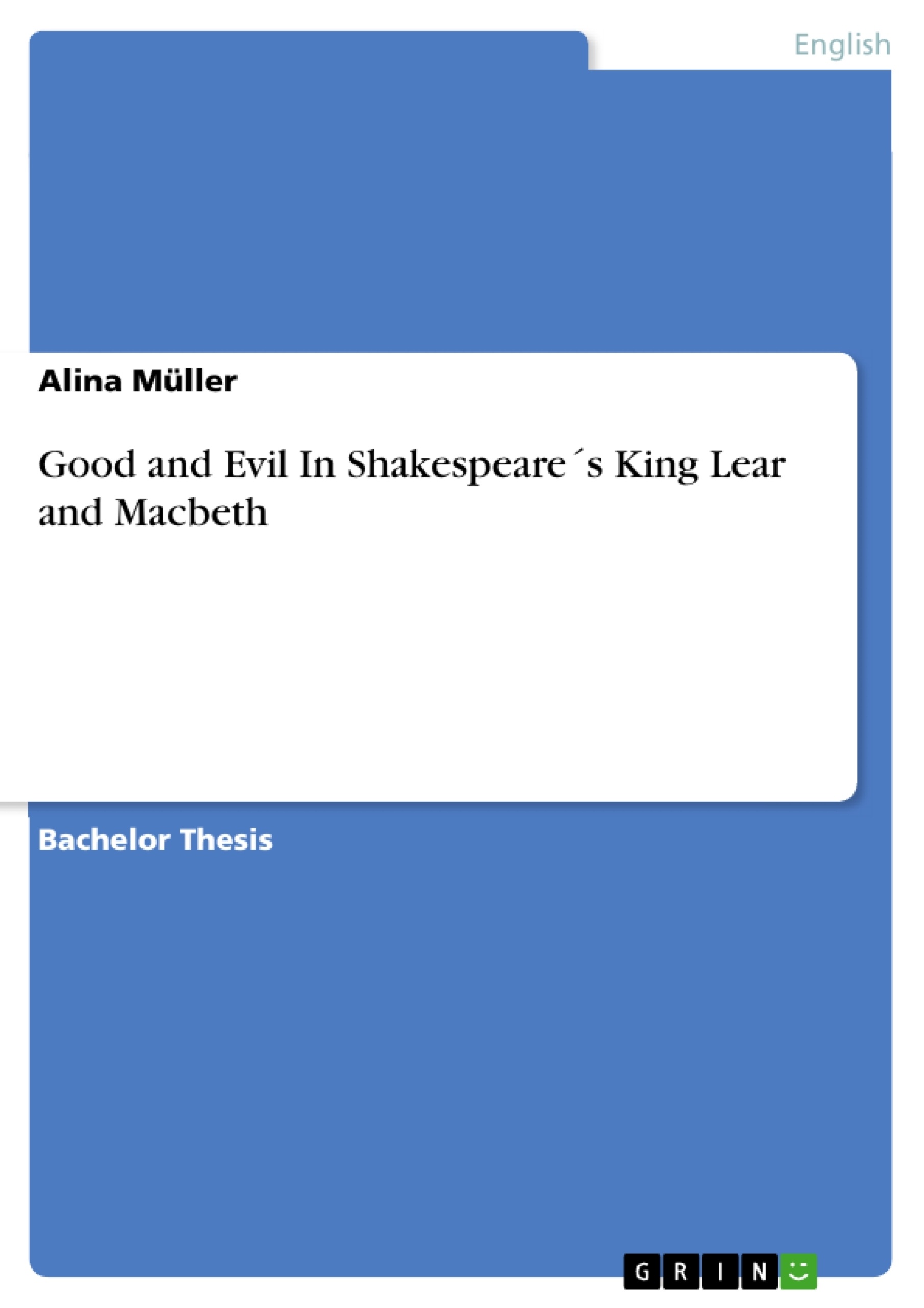
Good and Evil In Shakespeare´s King Lear and Macbeth
Bachelorarbeit, 2012
34 Seiten, Note: 2,0
Leseprobe
Table of Contents
- 1. Introduction
- 2. The Concepts of Good and Evil in Renaissance
- 3. Good and Evil in King Lear and Macbeth
- 3.1 Forces of Goodness: Cordelia and Banquo
- 3.2 Forces of Evil: Edmund and Lady Macbeth
- 3.3 Challenging Concepts of Good and Evil: Lear and Macbeth
- 4. Resolving Evil? The Final Scenes
Objectives and Key Themes
This thesis explores the complexities of good and evil within the context of Shakespeare's tragedies, King Lear and Macbeth. It examines how the concepts of good and evil were understood during the Renaissance, contrasting them with medieval interpretations. The analysis focuses on the portrayal of specific characters, exploring their actions and motivations to determine their alignment with concepts of good, evil, or a morally ambiguous space between.
- The evolving definitions of good and evil from the Medieval period to the Renaissance.
- The contrasting portrayals of virtuous and villainous characters in King Lear and Macbeth.
- The exploration of morally ambiguous characters and their roles in the plays' narratives.
- The presentation of the conflict between good and evil and its resolution (or lack thereof) in the plays.
- The impact of Renaissance societal structures and beliefs on the perception of morality.
Chapter Summaries
1. Introduction: This introductory chapter establishes the central focus of the thesis: examining the problematic nature of defining good and evil in Shakespeare's tragedies, King Lear and Macbeth. It highlights the shifting perceptions of these concepts from the Middle Ages, where good and evil were largely attributed to God and the Devil respectively, to the Renaissance, where a more humanist perspective placed their origins within human nature and societal structures. The chapter lays the groundwork for the subsequent exploration of specific characters and their actions within the plays, foreshadowing the complexities of moral judgment within the plays. It clearly states the aim of the thesis to analyze the characters' moral ambiguities and their alignment with concepts of good and evil.
2. The Concepts of Good and Evil in Renaissance: This chapter delves into the contrasting views of good and evil during the Middle Ages and the Renaissance. It explores the medieval perspective, which attributed good to God and evil to the Devil, often manifested through allegorical personifications in morality plays. In contrast, the Renaissance saw a shift toward placing the origins of good and evil within human nature, influenced by the hierarchical societal structures of the time. Evil actions were seen as those disrupting the established social and natural order. The chapter provides crucial context for understanding the later analysis of characters in Shakespeare's plays, by highlighting the fundamentally different ways in which moral concepts were perceived during the period of Shakespeare's writing.
Frequently Asked Questions: A Comprehensive Language Preview
What is the main topic of this academic preview?
This preview provides a structured overview of an academic thesis exploring the complexities of good and evil in Shakespeare's tragedies, King Lear and Macbeth, specifically within the context of Renaissance thought.
What are the key themes explored in the thesis?
The thesis examines the evolving definitions of good and evil from the Medieval period to the Renaissance, contrasting portrayals of virtuous and villainous characters in King Lear and Macbeth, exploring morally ambiguous characters, analyzing the conflict and resolution (or lack thereof) of good and evil in the plays, and investigating the impact of Renaissance societal structures on the perception of morality.
What is covered in the Table of Contents?
The table of contents includes an introduction, a chapter on the concepts of good and evil in the Renaissance, a chapter analyzing good and evil in King Lear and Macbeth (further subdivided into sections on forces of goodness, forces of evil, and morally ambiguous characters), and a concluding chapter on the resolution of evil in the final scenes of the plays.
How does the thesis approach the concept of good and evil?
The thesis contrasts the medieval understanding of good and evil (largely attributed to God and the Devil) with the Renaissance perspective, which placed the origins of good and evil within human nature and societal structures. It analyzes specific characters' actions and motivations to determine their moral alignment, acknowledging the presence of morally ambiguous characters.
Which Shakespearean plays are analyzed?
The thesis focuses specifically on William Shakespeare's tragedies, King Lear and Macbeth.
What specific characters are discussed?
The preview mentions Cordelia and Banquo as examples of characters representing forces of goodness, and Edmund and Lady Macbeth as representing forces of evil. Lear and Macbeth themselves are highlighted as morally ambiguous characters.
What is the purpose of the chapter summaries?
The chapter summaries provide concise overviews of the content and arguments presented in each chapter of the thesis. They highlight the key themes and arguments of each section, providing a roadmap for the reader.
What is the overall objective of this thesis?
The overall objective is to analyze the complex and often ambiguous portrayal of good and evil in Shakespeare's King Lear and Macbeth, considering the specific historical and cultural context of the Renaissance.
Who is the intended audience of this preview?
This preview is intended for academic use, allowing for the analysis of themes in a structured and professional manner. It serves as a comprehensive introduction to the thesis itself.
Where can I find more information?
This preview is a summary; for a complete analysis consult the full academic thesis.
Details
- Titel
- Good and Evil In Shakespeare´s King Lear and Macbeth
- Hochschule
- Johannes Gutenberg-Universität Mainz
- Note
- 2,0
- Autor
- Alina Müller (Autor:in)
- Erscheinungsjahr
- 2012
- Seiten
- 34
- Katalognummer
- V200565
- ISBN (eBook)
- 9783656275541
- ISBN (Buch)
- 9783656277507
- Dateigröße
- 648 KB
- Sprache
- Englisch
- Schlagworte
- problems good evil shakespeare´s tragedies king lear macbeth
- Produktsicherheit
- GRIN Publishing GmbH
- Preis (Ebook)
- US$ 27,99
- Preis (Book)
- US$ 38,99
- Arbeit zitieren
- Alina Müller (Autor:in), 2012, Good and Evil In Shakespeare´s King Lear and Macbeth, München, Page::Imprint:: GRINVerlagOHG, https://www.diplomarbeiten24.de/document/200565
- Autor werden
- Ihre Optionen
- Vertriebskanäle
- Premium Services
- Autorenprofil
- Textarten und Formate
- Services für Verlage, Hochschulen, Unternehmen

- © GRIN Publishing GmbH.
- Alle Inhalte urheberrechtlich geschützt. Kopieren und verbreiten untersagt.
- info@grin.com
- AGB
- Open Publishing
Der GRIN Verlag hat sich seit 1998 auf die Veröffentlichung akademischer eBooks und Bücher spezialisiert. Der GRIN Verlag steht damit als erstes Unternehmen für User Generated Quality Content. Die Verlagsseiten GRIN.com, Hausarbeiten.de und Diplomarbeiten24 bieten für Hochschullehrer, Absolventen und Studenten die ideale Plattform, wissenschaftliche Texte wie Hausarbeiten, Referate, Bachelorarbeiten, Masterarbeiten, Diplomarbeiten, Dissertationen und wissenschaftliche Aufsätze einem breiten Publikum zu präsentieren.
Kostenfreie Veröffentlichung: Hausarbeit, Bachelorarbeit, Diplomarbeit, Dissertation, Masterarbeit, Interpretation oder Referat jetzt veröffentlichen!
- GRIN Verlag GmbH
-
- Nymphenburger Str. 86
- 80636
- Munich, Deutschland
- +49 89-550559-0
- +49 89-550559-10
- info@grin.com
-









